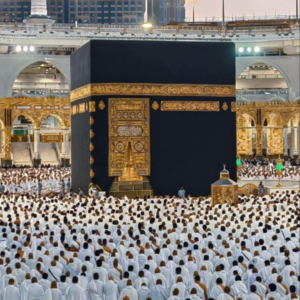Instructions to Perform Umrah
Fiqh (Islamic regulation and writing in view of the lessons of the blessed Quran and the practices of Prophet Muhammad) depicts exhaustively completing the customs of Umrah, and travelers for the most part follow handbooks and master advisers for effectively satisfy the prerequisites of Umrah.

Stage 1
Niyyah
Each traveler must be clear about their aim (niyyah) whether for Umrah or Hajj before they start their excursion.
Stage 2
Ihram
Ihram is a holy state where each explorer should enter prior to crossing the journey limit, known as Mīqāt, both truly and profoundly.
They abandon material life and leave into a condition of accommodation for Allah.
A traveler should not utilize any fragrances on the body or on the robes, they should be perfect (refined) prior to wearing the white consistent ihram clothing (different for people), and afterward implore two Raka’at (units of Islamic supplications) of Salah al-ihram flagging the beginning of an explorer’s ihram.
There are other different rules for Ihram that are obligatory (Mustahab) as educated by
the Prophet (PBUH) and others that are best.
While flying on journey, measures are frequently taken with the goal that explorers will stay in the province of Ihram while hovering above or close by the stations of Miqat (the objective focuses from where pioneers start their Hajj and Umrah).
The Ihram is intended to show balance of all travelers with no contrast between the rich and poor people, people before Allah.
There are different objective choices for Miqat around the Masjid AlHaram (The Incomparable Mosque of Makkah) limits for explorers heading out to the sacred land:
- Dhu’l Hulaifah (Abbyar Ali) is the miqat for travelers coming from or through Madinah
- Al-Juhfah (close to Rabigh) is the miqat for explorers coming from or through the Levant nations, Morocco, Egypt or Sudan.
- Qarn-al manazil (As-Sail Al-Kabeer) is the miqat for explorers coming from or through Najd or Taif, including the GCC nations.
- Yalamlam (Sa’adiyah) is the miqat for explorers coming from or through India, Pakistan or Yemen.
- Dhat ‘Irq is the miqat for explorers coming from or through Iraq.
Stage 3
Talbiyah
Talbiyah is the extraordinary petitioning heaven expressed while on the excursion towards Makkah, in request to accomplish Ihram. It is the conviction that travelers plan to perform Umrah just for Allah. By rehashing it again and again, they prepare themselves for the profound excursion and further from non-otherworldly worries. Every traveler needs to rehash the request:
- “لَبَّيْكَ ٱللَّٰهُمَّ لَبَّيْكَ، لَبَّيْكَ لَا شَرِيكَ لَكَ لَبَّيْكَ، إِنَّ ٱلْحَمْدَ وَٱلنِّعْمَةَ لَكَ وَٱلْمُلْكَ لَا شَرِيكَ لَكَ”
- “Here I am O Allah, I’m right here. I’m right here. You have no accomplices (different divine beings). To You alone is all commendation and all greatness, and to You is all power. There is no accomplice to You.”
Stage 4
Tawaf
After entering the heavenly mosque in Makkah, each individual ought to perform Tawaf. This is the demonstration of orbiting around the Kaaba counterclockwise multiple times.
Tawaf starts and finishes from the consecrated dark stone situated before the Kaaba. During Tawaf, explorers will rehash any Dhikr (expressions of petitions) that they wish to say. While crossing the dark stone it is a Sunnah (a conventional act of the Prophet (PBUH)) to rehash this Dua’a (supplication).
- “ربنا آتنا في الدنيا حسنة وفي الآخرة حسنة وقنا عذاب النار”
- “Rabina Atina Fid-Dunya Hasanatan Wa Fil Akhirati Hasanatan Waqina Adhaban-Nar”
- While confronting the dark stone, pioneers will lift their right hand and rehash “Allahu Akbar” – God is the Best.
The initial three rounds ought to be quick and the leftover four ought to be more slow (by and by today notwithstanding; the sheer number of pioneers makes everybody go more slow). Toward the finish of the Seventh circle, travelers will offer two Raka’at (units of Islamic petitions) before Makam Ibrahim (a stone that implies crafted by Ibrahim and Ismail who dealt with modifying the Kaaba).
Stage 5
Sa'i
Sa’i is the custom of strolling to and fro between two slopes known as Safa and Marwa multiple times.
- “إن الصفا والمروة من شعائر الله فمن حج البيت أو اعتمر فلا جناح عليه أن يطّوّف بهما ومن تطوع خيرًا فإن الله شاكر عليم” [البقرة 158]
- {Al Safa and Al Marwa are among the images of Allah. It’s anything but a transgression on whoever performs Hajj or Umrah in the place of Allah to perform Tawaf between them. Furthermore, whoever does great everything is knowing and is appreciative} [Surah Al-Baqarah 158]
- During the stroll between the two slopes, explorers give any Dua’a (supplication) they wish to make for themselves, families or friends and family. Each Muslim strolling between the two slopes is remembering the narrative of Hagar, Prophet Ibrahim’s better half who frantically ran multiple times between the two slopes looking for water for her parched child. Her hunt possibly finished when Ismail stepped his foot and the water of Zamzam all around came spouting from the spot. Explorers should pace between the two focuses multiple times also. After petition at Maqam Ibrahim, travelers additionally hydrate from the Zamzam well, which is made accessible in coolers all through the Mosque.
Stage 6
Halq or Taqsir
Each explorer performing Umrah should either trim their hair or shave it totally (for ladies, it’s regularly trimming simply a solitary lock of hair) to mean resurrection and immaculateness after their otherworldly excursion. This act flags the exit of the pioneer’s Ihram and marks the finish of the Umrah interaction.

